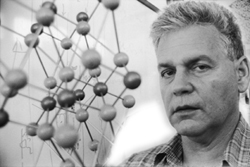Toast 'em, roast 'em, shape 'em, salt 'em: Chip consumption has reached an all-time high. The consumer can't get enough of them, as the market clamors for the bigger, better and more perfect chip. There's another chip to add to the pile: computer chips. And make that with an extra dose of memory, please.
It all has to do with the law of supply and demand. The constant, urgent need for increased computer memory best exemplifies this theory.
While most computer users may not be aware of it, scientists and entrepreneurs worldwide are working nonstop to develop ways of creating more efficient and smaller-sized computer memory, as the demand for more minute and efficient memory continues to increase. But computer chip memory isn't just mixed in a test kitchen before hitting the shelves. This "recipe" calls for finetuning of molecules and molecular structure. Computer memory is built from a large number of "switches" capable of being in one of two positions that can be called "on" or "off."
The switches in most computer memories are built of blocks of magnetic material, where a change in its magnetic polarity determines whether they change from on or off (or vice versa, as the instruments' developers determine).
In order to increase, as much as possible, the amounts of data that can be stored in any given physical space, scientists are being asked to constantly reduce the size of each switch. To what extent is this possible? Until every switch is based on only one molecule of material.
In various places around the world, and notably, at the Weizmann Institute of Science, different types of molecular switches have already been created. That's the good news. The bad news: The experiments for applying them to the construction of multiswitch computer memory have run into new obstacles. The ideal magnetic switch must be characterized by the low power of its magnetism (which allowsits magnetic polarity to be changed easily), and its stability (which allows the data to be stored reliably over long periods of time).
In other words, scientists trying to develop the molecular magnetic switches are searching for a material that is well-defined chemically, i.e., a pure substance, which contains only one type of molecule with no impurities, organized into a defined multimolecular spatial structure characterized by defined magnetic properties. At the same time it must also be resistant, as much as possible, to environmental effects: electrical fields, temperature changes, etc.
Unfortunately, demanding that all these properties exist together involves a catch. When single molecules comprising molecular switches are located very close to one another, any change in the magnetic polarity of one (for example, as a result of a temperature change), is liable to bring about a change in the magnetic polarity of its neighboring molecular switch. This effectively damages the ability of the medium to be used as a computer memory store or for it to reliably store data over the long term.
One proposal to solve this situation was recently made by Prof. Reshef Tenne of the Materials and Interfaces Department of the Weizmann Institute of Science. With colleagues Dr. Enrique Grunbaum of Weizmann and Drs. Jeremy Sloan and John Hutchinson of the University of Oxford, Prof. Tenne and his research student, Yaron Rosenfeld Hacohen, succeeded in creating a single molecular layer in a spherical shape, like a soccer ball, made from nickel-chloride molecules. The molecules are expected to have defined magnetic properties on one hand, and relative resistance to changing environmental conditions on the other. In effect, these are molecules capable of serving as magnetic memory switches with a high degree of reliability. Their findings are now being published in the prestigious international journal Nature.
Prof. Tenne and Rosenfeld Hacohen have also succeeded in creating tiny molecular "pipes" from nickel-chloride molecules. Tenne was the first to show that it's possible to build the molecular nanotubes from inorganic materials. Observation was done on a very small number of objects of this kind. In order to characterize and measure their properties, millions of such structures must first be synthesized. While research is in its earliest stages, it's hoped the nanotubes might one day serve a relatively large number of industrial applications, including their use as tools for "writing" magnetic data onto computer disks, and also for "reading" the data stored on such disks. The unique properties of nickel-chloride are likely to make it possible to read and write magnetic data, both optical and electrical, as one.
Another possible application of the new molecular tubes is to control the manufacture of computer chips. Additional uses? That's part of the thrill of the scientific process. It's probable that the greatest and most important employment of the first inorganic molecular tubes is yet to come.
